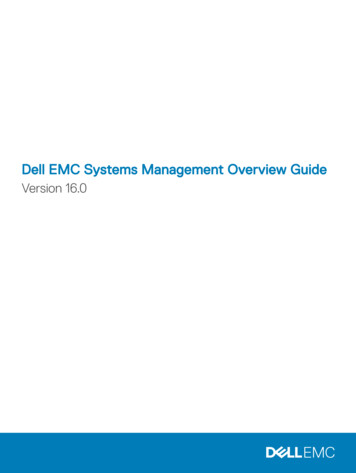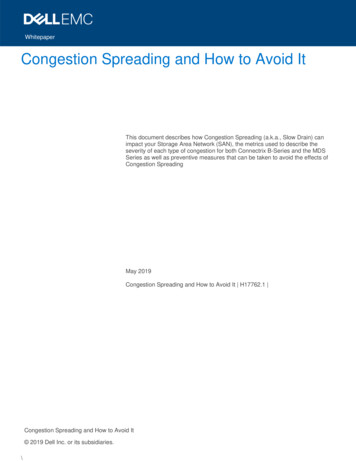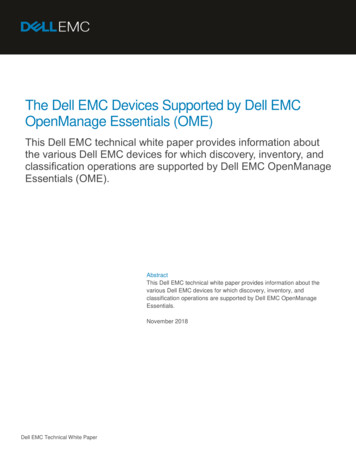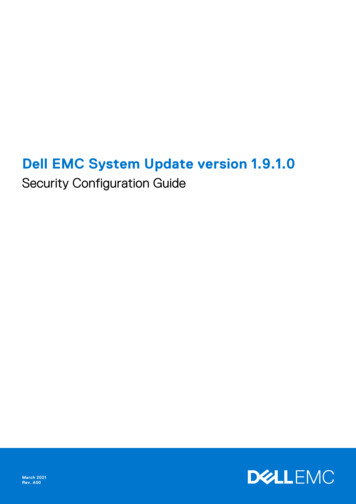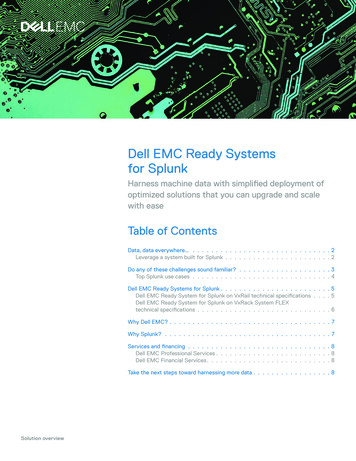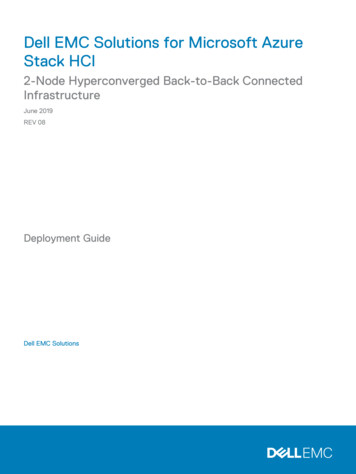
Transcription
Dell EMC Solutions for Microsoft AzureStack HCI2-Node Hyperconverged Back-to-Back ConnectedInfrastructureJune 2019REV 08Deployment GuideDell EMC Solutions
Copyright 2018-2019 Dell EMC All rights reserved.Dell believes the information in this publication is accurate as of its publication date. The information is subject to change without notice.THE INFORMATION IN THIS PUBLICATION IS PROVIDED “AS-IS.” DELL MAKES NO REPRESENTATIONS OR WARRANTIES OF ANY KIND WITHRESPECT TO THE INFORMATION IN THIS PUBLICATION, AND SPECIFICALLY DISCLAIMS IMPLIED WARRANTIES OF MERCHANTABILITY OR FITNESSFOR A PARTICULAR PURPOSE. USE, COPYING, AND DISTRIBUTION OF ANY DELL SOFTWARE DESCRIBED IN THIS PUBLICATION REQUIRES ANAPPLICABLE SOFTWARE LICENSE.Dell Technologies, Dell, EMC, Dell EMC and other trademarks are trademarks of Dell Inc. or its subsidiaries. Other trademarks may be the property of theirrespective owners. Published in the USA.Dell EMCHopkinton, Massachusetts 01748-91031-508-435-1000 In North America 1-866-464-7381www.DellEMC.com2Dell EMC Solutions for Microsoft Azure Stack HCI
CONTENTSChapter 1Overview5Introduction.6Audience and scope.6Assumptions. 6Known issues. 7Chapter 2Virtualization infrastructure with Dell EMC Ready Nodes9Overview.10R640 Storage Spaces Direct Ready Node. 12Storage Spaces Direct. 13Chapter 3Solution component integration15Overview.16Network connectivity.16Chapter 4Virtualized infrastructure deployment by using Dell EMC ReadyNodes19Overview. 20Deployment prerequisites. 20Software versions.20Dell EMC validated firmware matrix. 21Deployment checklists. 21Management environment checklist.21Network configuration checklist.21Host OS network checklist. 22Predeployment configuration. 23Network switch configuration.23iDRAC and BIOS configuration. 24QLogic NIC configuration. 26Firmware baselining. 29Chapter 5Hyperconverged infrastructure deployment31Overview. 32Deploy operating system. 32Manual OS deployment.32Factory-installed OS.32Update out-of-box drivers. 33Install roles and features.34Change hostname.34Configure firewall. 34Configure host networking. 35VM switch and adapter configuration. 35Dell EMC Solutions for Microsoft Azure Stack HCI3
ContentsAD domain join. 37Create host cluster.38Configuring Storage Spaces Direct. 38Change RDMA mode on QLogic NICs—iWARP only. 39Update page file settings.39Enabling jumbo frames. 40Remove host management network from Live Migration.40Update hardware timeout for Spaces port. 41Configuring a cluster witness. 41Recommended next steps. 41Chapter 6Deployment services43Overview. 444Appendix AAdditional resources45Appendix BFirewall port requirements47Appendix CSample deployment checklists49Dell EMC Solutions for Microsoft Azure Stack HCI
CHAPTER 1OverviewThis chapter presents the following topics:llllIntroduction. 6Audience and scope. 6Assumptions.6Known issues.7Dell EMC Solutions for Microsoft Azure Stack HCI5
OverviewIntroductionThis guide focuses on deploying a 2-node back-to-back connected hyperconvergedinfrastructure solution for Microsoft Azure Stack HCI. The guide includes an overviewof the solution infrastructure, guidance on how to integrate the solution components,and instructions for preparing and deploying the solution infrastructure. This guide isapplicable only to infrastructure that is built by using the validated and certified DellEMC Microsoft Storage Spaces Direct Ready Nodes.Audience and scopeThe audience for this document includes systems engineers, field consultants, partnerengineering team members, and customers with a fair amount of knowledge indeploying hyperconverged infrastructures with Microsoft Windows Server 2016 orWindows Server 2019 Hyper-V and Storage Spaces Direct.Customers who do not have Volume License agreements with Microsoft can order DellEMC Microsoft Storage Spaces Direct Ready Nodes with the operating systempreinstalled at the factory with OEM license or bare metal.The Storage Spaces Direct Cluster deployment can be done in two ways:lDell EMC Services led: Certified deployment engineers can deploy the solution,which ensures accuracy and speed, reduced risk and down time.lCustomer led: Customers can deploy the solution by referring to this deploymentguide, provided they have the qualified level of technical expertise.Note: Instructions in this deployment guide are applicable only to the generallyavailable OS build of Windows Server 2016 with the latest applicable updates andWindows Server 2019 GA build with latest OS updates. These instructions are notvalidated with Windows Server, version 1709. Storage Spaces Direct Ready nodesdo not support the Windows Server Semi-Annual Channel release. Dell EMCrecommends that you update the host OS with latest cumulative updates fromMicrosoft before starting the cluster creation and configuration tasks.Note: While the instructions in this deployment guide can be used with other DellEMC Microsoft Storage Spaces Direct Ready Nodes, R640 Storage Spaces DirectReady Node has been used as an example for the deployment instructions.AssumptionsThis deployment guide makes certain assumptions about the necessary prerequisiteknowledge of the deployment personnel. This includes the prerequisite knowledge of:6lDell EMC Microsoft Storage Spaces Direct Ready Nodes and deploying andconfiguring BIOS and iDRAC settingslDeploying and configuring Windows Server 2016 and Windows Server 2019 HyperV infrastructureDell EMC Solutions for Microsoft Azure Stack HCI
OverviewKnown issuesBefore starting the cluster deployment, ensure that you review the known issues andworkarounds. See l EMC Solutions for Microsoft Azure Stack HCI7
Overview8Dell EMC Solutions for Microsoft Azure Stack HCI
CHAPTER 2Virtualization infrastructure with Dell EMCReady NodesThis chapter presents the following topics:lllOverview. 10R640 Storage Spaces Direct Ready Node. 12Storage Spaces Direct. 13Dell EMC Solutions for Microsoft Azure Stack HCI9
Virtualization infrastructure with Dell EMC Ready NodesOverviewDell EMC Solutions for Azure Stack HCI encompasses various configurations ofR740xd, R740xd2, and R640 Storage Spaces Direct Ready Node and PowerEdgeR440 servers to power the primary compute cluster deployed as a hyperconvergedinfrastructure. This hyperconverged infrastructure built by using these Ready Nodesuses a flexible solution architecture rather than a fixed component design. Figure 1illustrates one of the flexible solution architectures consisting of compute clusteralongside the redundant top-of-rack switches, a separate out-of-band (OOB)network, and an existing management infrastructure in the data center.The Dell EMC Solutions for Azure Stack HCI based on Dell EMC Storage SpacesDirect Ready Nodes is available in both hybrid and all-flash configurations.For more information on available configurations, see Dell EMC Ready Nodes forMicrosoft Storage Spaces Direct with Hyper-V Solution Overview.Note: For the 2-node cluster deployment, it is mandatory that a cluster witness isconfigured. See the section on configuring cluster witness for available optionsand other references to deployment instructions.10Dell EMC Solutions for Microsoft Azure Stack HCI
Virtualization infrastructure with Dell EMC Ready NodesFigure 1 2-Node hyperconverged virtualized solution using Dell EMC Ready NodesDell EMC Solutions for Azure Stack HCI does not include management infrastructurecomponents such as a cluster for hosting management VMs and services such asActive Directory (AD), Domain Name Service (DNS); Windows Server UpdateServices (WSUS); and System Center components such as Operations Manager(OM). Therefore, the instructions in this guide do not include deployment of any ofthese services and components, and assume that at least an Active Directory domaincontroller is available in the existing management infrastructure.When deployed in a remote office scenario, Dell EMC recommends that you deployeither an Active Directory replica or Ready-Only Domain Controller (RODC) at theremote office. If you are using a RODC at the remote site, connectivity to the centralmanagement infrastructure with a writeable domain controller is mandatory duringdeployment of the 2-node cluster.The subsequent sections provide an overview of the hardware and softwarecomponents in the virtualized solution based on Dell EMC Ready Nodes.Dell EMC Solutions for Microsoft Azure Stack HCI11
Virtualization infrastructure with Dell EMC Ready NodesR640 Storage Spaces Direct Ready NodeR640 Storage Spaces Direct Ready Node, a 1U rack server based on the PowerEdgeR640, is optimized for software-defined storage implementations that enablehyperconverged infrastructure (HCI) implementations. This Ready Node supports upto two CPU sockets, with a wide range of options for the number of cores per CPUsocket, and 1.5 TB of memory when using DDR4 DIMMs.The R640 Storage Spaces Direct Ready Node in a back-to-back connectedconfiguration is available only in a 10-drive chassis configuration in both hybrid and allflash configurations. For more details about the configuration, see https://www.dell.com/learn/shared-content data-sheets en/documents n-overview-en.pdf.Figure 2 Disk configuration in a Dell EMC Ready Node based on R640 Storage Spaces DirectReady Node with 10 drives (hybrid)Figure 3 Disk configuration in a Dell EMC Ready Node based on R640 Storage Spaces DirectReady Node with 10 drives (all-flash)The R640 Storage Spaces Direct Ready Node in a back-to-back connectedconfiguration supports only one add-in network adapter.12Dell EMC Solutions for Microsoft Azure Stack HCI
Virtualization infrastructure with Dell EMC Ready NodesThe following table provides an overview of the R640 Storage Spaces Ready Node inthe solution.Table 1 System componentsComponentSpecificationCompute cluster nodeR640 Storage Spaces Ready NodeNIC1 x Mellanox Connectx-4 LX 25 GbE SFP add-in adapteror1 x QLogic FastLinQ 41262 25 GbE SFP28 add-in adapterandDual-port 10 GbE or dual-port 1 GbE rNDCStorage adapterHBA 330 MiniBoot deviceBOSS S.1 with 2 x BOSS M.2 devices in RAID 1DrivesSee Dell EMC Ready Nodes for Microsoft StorageSpaces Direct with Hyper-V Solution OverviewBecause this 2-node configuration implements back-to-back connectivity of theservers using either the Mellanox or QLogic RDMA-capable NICs, a data centerbridging (DCB) policy or RoCE for RDMA configurations in the host operating systemare not needed.If the nodes are configured with QLogic FastLinQ 41262 adapters, Dell EMCrecommends using iWARP for RDMA.For a list of switches that are supported in this configuration, see the Support Matrixat https://www.dell.com/azurestackhcimanuals.Storage Spaces DirectStorage Spaces Direct was first introduced in Windows Server 2016. This storagefeature uses the local disks within the nodes to create highly available softwaredefined storage. This feature is enhanced further in Windows Server 2019 with theaddition of support for deduplication among many other features and enhancements.Two deployment options are possible for Storage Spaces Direct. In the first option,the storage and compute cluster are kept separate. This method, which is known asconverged or disaggregated deployment, allows for scaling of storage and computeclusters in a manner that is independent of each other. The second deploymentoption, known as hyperconverged deployment, enables running the virtualizationservices directly on top of the servers that host Storage Spaces Direct. This methodensures that there is no need to configure and maintain file services separately in adifferent cluster and, therefore, reduces the need for additional physical servers.This deployment guide focuses on a hyperconverged deployment of Storage SpacesDirect. For more information about Storage Spaces Direct and these deploymentoptions, see -overview.This guide provides the deployment instructions for implementing a Storage SpacesDirect hyperconverged cluster that is built using Dell EMC Ready Nodes. The followingfigure provides an overview of the deployment.Dell EMC Solutions for Microsoft Azure Stack HCI13
Virtualization infrastructure with Dell EMC Ready NodesFigure 4 Deployment overview14Dell EMC Solutions for Microsoft Azure Stack HCI
CHAPTER 3Solution component integrationThis chapter presents the following topics:llOverview. 16Network connectivity. 16Dell EMC Solutions for Microsoft Azure Stack HCI15
Solution component integrationOverviewThis section provides recommendations on server and network switch placement inthe racks and port mapping on the top-of-rack (TOR) switches.Figure 5 Solution components integration for a 2-Node back-to-back connected configurationNetwork connectivityEach R640 Storage Spaces Direct Ready Node can be configured with either MellanoxConnectX-4 LX or QLogic FastLinQ 41262 25 GbE network adapters for storagetraffic and a dual-port 10 GbE or dual-port 1 GbE rNDC for host management and VMtraffic. Each port from the Mellanox or QLogic network adapters get connecteddirectly to the respective ports on the second server.For host management and VM traffic, the ports on the rNDC can be used. Thefollowing network connectivity diagrams illustrate using either 10 GbE SFP ports or 1Gb BASE-T ports for host management and VM traffic.16Dell EMC Solutions for Microsoft Azure Stack HCI
Solution component integrationFigure 6 Network connectivity when using 10 GbE ports on the rNDC for host management andVM trafficNote: Our-of-band (OOB) ports from the servers use Base-T connectivity.Therefore, connecting these ports to a SFP switch port requires a 10 GbE SFP to Base-T transceiver.Dell EMC Solutions for Microsoft Azure Stack HCI17
Solution component integrationFigure 7 Network connectivity when using 1 GbE ports on the rNDC for host management andVM trafficThe dedicated iDRAC management ports can be connected to a separate 1 Gb Base-Tport at the remote site.Note: This topology supports both tagged and untagged VLANs for storagetraffic.18Dell EMC Solutions for Microsoft Azure Stack HCI
CHAPTER 4Virtualized infrastructure deployment by usingDell EMC Ready NodesThis chapter presents the following topics:llllOverview.20Deployment prerequisites. 20Deployment checklists. 21Predeployment configuration. 23Dell EMC Solutions for Microsoft Azure Stack HCI19
Virtualized infrastructure deployment by using Dell EMC Ready NodesOverviewThe 2-Node back-to-back connected configuration in Dell EMC Solutions for AzureStack HCI can be deployed in either of the following ways:lManual OS deployment—A manual method of installation from OS deploymentthrough cluster creationlFactory OS deployment—Factory preinstallation of Windows Server 2016 orWindows Server 2019 on the R640 Storage Spaces Direct Ready Node serversEach of the methods has deployment prerequisites and predeployment configurationrequirements, including the network switch configuration.Subsequent sections of this guide describe the deployment prerequisites for each ofthese methods and also provide details on the supported software and firmwareversions.Note: Storage Spaces Direct was first introduced in Windows Server 2016. Thisstorage feature uses the local disks within the nodes to create highly availablesoftware-defined storage. This feature is enhanced further in Windows Server2019 with the addition of support for deduplication, among many other featuresand enhancements. Dell EMC recommends updating the host OS with the latestcumulative updates from Microsoft before creating and configuring a cluster.Deployment prerequisitesDeployment of this hyperconverged virtualized solution based on Dell EMC ReadyNodes assumes that the management services that are required for the OSdeployment and cluster configuration are present in the existing infrastructure wherethe Storage Spaces Direct cluster deployment is being done.The following table describes management services, their purpose, and whetherdeployment is required or optional.Table 2 Management servicesManagement servicePurposeDeployment—required/optionalActive DirectoryUser authenticationRequiredDomain Name ServiceName resolutionRequiredWindows Software UpdateService (WSUS)Local source for WindowsUpdatesOptionalSoftware versionsThe following table lists the software versions that are required for the Dell EMCReady Nodes deployment.20Dell EMC Solutions for Microsoft Azure Stack HCI
Virtualized infrastructure deployment by using Dell EMC Ready NodesTable 3 Software versionsComponentVersionOperating SystemWindows Server 2016 or Windows Server2019 Data CenterActive Directory Forest/domain functionallevelWindows Server 2008 R2 or laterDell EMC validated firmware matrixDell EMC Solutions for Azure Stack HCI are validated and certified with certainfirmware versions that are related to solution infrastructure components. The supportmatrix identifies the Dell EMC validated versions of software and firmware to be usedto ensure that the solution infrastructure remains supported and delivers optimalperformance.The support matrix is available at https://www.dell.com/azurestackhcimanuals. It isupdated as software and firmware revisions are validated.Deployment checklistsThis section provides checklists for use in gathering information about themanagement environment, network configuration, and host OS network. Fill in thechecklists before proceeding to the predeployment configuration.Sample deployment checklists on page 49 provides completed examples of thesechecklists for reference.Management environment checklistThis Dell EMC Ready Nodes deployment is a brownfield deployment and, therefore,requires information such as Active Directory domain FQDN, DNS server addresses,and so on.The following table captures the necessary inputs as a checklist.Table 4 Management environment checklistItemValueActive Directory domain FQDNDomain administrator or equivalentcredentialsDNS server addressesWSUS server FQDN (optional)Network configuration checklistBefore starting the deployment, identify the IP scope and VLAN information forvarious traffic classes in the solution infrastructure. The Minimum IP addressesneeded column in the following table can be used to identify the correct scope. TheDell EMC Solutions for Microsoft Azure Stack HCI21
Virtualized infrastructure deployment by using Dell EMC Ready Nodesvalue shown in that column is based on the number of components that require thespecified traffic class used in this solution. Ensure that the IP scope that is selectedfor the traffic class meets the minimum IP addresses requirement.The IP scope information in the following table is provided only an example. Selectvalues based on your existing data center architecture.Consult with the customer network engineering team for VLAN ID and VLAN IPaddresses applicable to your solution.Table 5 Network configurationTraffic classPurposeMinimum IPaddressesneededOut of bandRequired forOOBmanagement ofserver nodesand TORswitchesHostManagementStorage 1Storage 2Tagged/untaggedIP addressspace2Untagged/24Management ofcluster andcluster nodes3Tagged/untagged/25SMB traffic2Tagged/untagged/27Tagged/untagged/27SMB trafficVLAN ID2VLAN IPaddressesTOR1:TOR2:TOR1:TOR2:TOR1:TOR2:TOR and OOB switch configuration might also require configuring settings such ashostnames, IP routes, and so on. The following table captures these requirements as achecklist.Table 6 Network configuration checklistItemValueOOB switch hostnameTOR1 switch hostnameTOR2 switch hostnameEnable passwordAdditional user/passwordIP route on OOB (if needed)IP route on TOR1/TOR2 (if needed)Host OS network checklistDell EMC recommends having consistent host naming and IP addressing acrossmultiple nodes in the virtualized cluster deployment. The host OS network22Dell EMC Solutions for Microsoft Azure Stack HCI
Virtualized infrastructure deployment by using Dell EMC Ready Nodesconfiguration includes naming for the virtual switches and adapters, and assigninghostnames and IP addresses.The following table provides the checklist for capturing the host OS network switchand adapter details.Table 7 Host OS network switch and adapter detailsItemValueVirtual switch (for management/VM traffic)Management adapter nameFor the host OS configuration in any deployment method, static IP addressassignment is recommended for all networks. The following table provides thechecklist for capturing the details of the host OS network.Table 8 Host OS network checklistHostnameManagementIPStorage1 IPStorage2 IPOOB IPOOBhostnameNode 1Node 2Predeployment configurationThis section describes the predeployment configuration that must be performedbefore deploying the hyperconverged virtualized solution based on Dell EMCMicrosoft Storage Spaces Direct Ready Nodes.Network switch configurationWhen considering the hyperconverged network topology of the Storage Spaces Directsolution, network resiliency is a critical option that is achieved from both a physicaland logical standpoint.Dell EMC recommends that you deploy a network topology that supports a dualcontrol plane while sharing a single data plane. The Dell EMC proprietary technology isreferred to as Virtual Link Trunking (VLT). This technology provides network resiliencyfor data I/O.For sample switch configurations for Dell EMC Networking switches, see https://community.emc.com/docs/DOC-70310.Because these Ready Nodes use back-to-back connections for storage traffic, onlythree basic networks are needed for a standard Storage Spaces Direct infrastructure—switch management, out-of-band (OOB) management, and host management.Dell EMC Solutions for Microsoft Azure Stack HCI23
Virtualized infrastructure deployment by using Dell EMC Ready NodesTable 9 Solution network VLANsVLAN networktypeMinimal networkmaskNumber of IPaddressesVLAN ID tag/untagOOB and switchmanagement/424(255.255.255.0)UntaggedHost C and BIOS configurationThe R640 Storage Spaces Direct Ready Nodes are pre-configured at the factory forStorage Spaces Direct optimized BIOS and iDRAC configuration setting. By default,iDRACs are configured to use DHCP for IPv4 and IPv6 addresses.Note: PowerEdge R440 servers are not factory configured with the MicrosoftStorage Spaces Direct optimized BIOS and iDRAC configuration settings. Forthese servers, you must update the BIOS and iDRAC configuration settings beforedeployment. The list of all optimized configuration settings is available at https://www.dell.com/support/article/sln313842.If static IPv4 configuration is needed for the iDRAC dedicated network interface,follow the steps given below:1. Press F2 during POST.Figure 8 Enter iDRAC2. Select iDRAC Settings.24Dell EMC Solutions for Microsoft Azure Stack HCI
Virtualized infrastructure deployment by using Dell EMC Ready NodesFigure 9 System Setup main menu3. Select Network.Figure 10 Network Settings4. In IPV4 Settings, against Enable DHCP, select Disabled and enter the static IPaddress.Dell EMC Solutions for Microsoft Azure Stack HCI25
Virtualized infrastructure deployment by using Dell EMC Ready NodesFigure 11 IPv4 Settings5. Click Back, and then click Finish to return to the System Setup page.6. Click Finish.QLogic NIC configurationQLogic FastLinQ 41262 network adapter supports both iWARP and RoCE for RDMA.The Storage Spaces Direct Ready Nodes are validated with only iWARP for RDMAwhen using the QLogic network adapters and therefore based on the networkconfiguration chosen, you must configure the adapter manually to enable iWARP forRDMA.About this taskPerform the following steps for each port to configure the QLogic network adapters.Procedure1. Press F2 during system boot to enter System Setup.2. Click System BIOS and select Device Settings.26Dell EMC Solutions for Microsoft Azure Stack HCI
Virtualized infrastructure deployment by using Dell EMC Ready NodesFigure 12 Device settings3. Select the QLogic network adapter from the list of adapters.Figure 13 System Setup4. Click Device Level Configuration and ensure that Virtualization Mode is set toNone.Dell EMC Solutions for Microsoft Azure Stack HCI27
Virtualized infrastructure deployment by using Dell EMC Ready NodesFigure 14 Virtualization mode5. Click Back, and then click NIC Configuration.6. Select the following options in the NIC Configuration page:lLink Speed—SmartANlNIC RDMA Mode—EnabledlRDMA Operational Mode—iWARPlBoot Protocol—NonelVirtual LAN Mode—DisabledFigure 15 NIC configuration options28Dell EMC Solutions for Microsoft Azure Stack HCI
Virtualized infrastructure deployment by using Dell EMC Ready Nodes7. Click Back and click Data Center Bridging (DCB) Settings.8. In the Data Center Bridging (DCB) Settings page, set DCBX Protocol toDisabled.Figure 16 DCB settings9. Click Back, and then click Finish. Click Yes to save the settings.10. Click Yes to return to the Device Settings page.11. Select the second port of the QLogic adapter and repeat the steps.12. Click Finish to return to the System Setup page.13. Click Finish to reboot the system.Firmware baseliningDell EMC Solutions for Azure Stack HCI have a validated set of firmware and driverrevisions, and the nodes in the HCI cluster must comply with the firmware matrix. It isimportant to ensure that each server has the right firmware revisions for componentsused within the server.This can be verified by using the system inventory feature of iDRAC, or OpenManageEssentials, or by using a command line interface such
R440 servers to power the primary compute cluster deployed as a hyperconverged infrastructure. This hyperconverged infrastructure built by using these Ready Nodes . a 1U rack server based on the PowerEdge R640, is optimized for software-defined storage implementations that enable hyperconverged infrastructure (HCI) implementations. This Ready .




